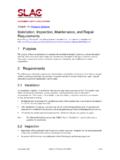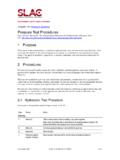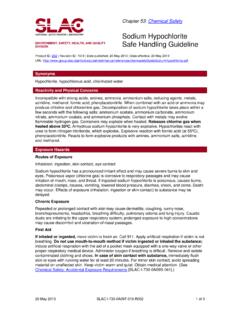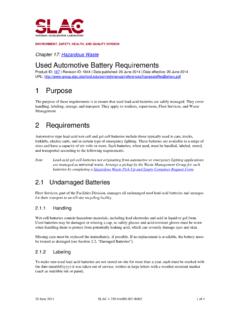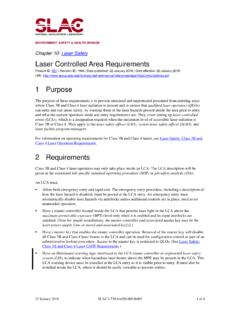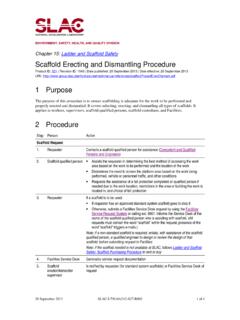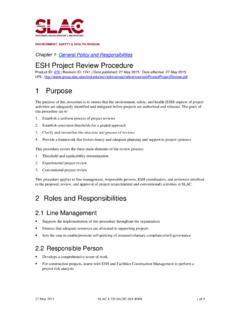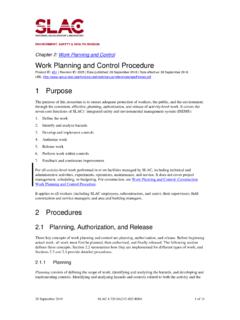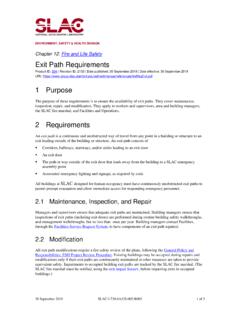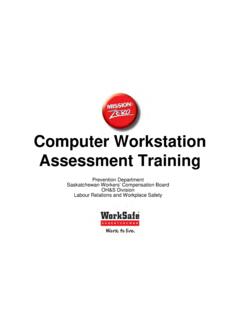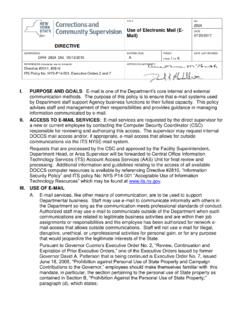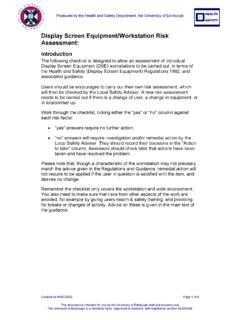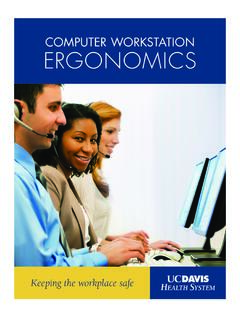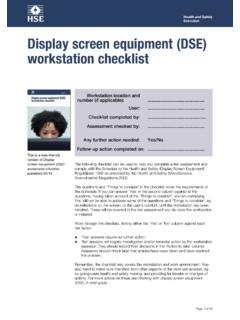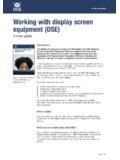Transcription of Ergonomic Evaluation Procedures - Stanford University
1 ENVIRONMENT, SAFETY & HEALTH DIVISION 20 July 2020 SLAC-I-730-0A21S-059-R003 1 of 6 Chapter 54: Ergonomics Ergonomic Evaluation Procedures Product ID: 657 | Revision ID: 2194 | Date published: 20 July 2020 | Date effective: 20 July 2020 URL: 1 Purpose The purpose of these Procedures is to prevent Ergonomic injuries. They cover identifying, evaluating, and mitigating Ergonomic risks. They apply to workers, supervisors, Ergonomic specialists, ESH coordinators, and the ergonomics program manager; and the Occupational Health Center (OHC) and Building and Space Management. 2 Procedures The following Procedures cover conducting office and non-office Ergonomic evaluations. But workers and supervisors should be actively screening activities and workplace conditions with potential Ergonomic risks and are strongly encouraged to engage their ESH coordinator or contact the program manager and/or OHC for assistance, ranging from informal consultations to formal evaluations.
2 Ergonomic Evaluation Office Office Ergonomic evaluations are formal, conducted by an OHC Ergonomic specialist, and documented in an Evaluation report. Step Person Action and worker If not previously completed within 2 years, worker is to complete ESH Course 291,Ergonomics Training - Office Worker (ESH Course 291) Worker and supervisor discuss results of ESH Course 291 workstation self- assessment and implement identified workstation corrective actions When warranted or desired, requests Ergonomic Evaluation by contacting OHC at or ext. 2281 ESH Course 291EV, Ergonomic Evaluation - Office Worker (ESH Course 291EV), to worker s SLAC Training assessment (STA) for an office Evaluation specialistand workerPerforms Evaluation at worker's computer workstation specialist Documents Evaluation and recommendations in Evaluation reportSends Evaluation report to supervisor and worker See the COVID-19 Resource Center for National Accelerator Laboratory Environment, Safety & Health Division Chapter 54 | Ergonomic Evaluation Procedures 20 July 2020 SLAC-I-730-0A21S-059-R003 2 of 6 Step Person Action 5.
3 Supervisor Implements recommendations noted in the Evaluation report, including, for example, procuring equipment and arranging for installation Reviews work practice recommendations with worker 6. Space Planning and Management When height-adjustable workstations are recommended, assists with selection and coordinates removal and installation 7. Worker Makes work practice modifications recommended in the Evaluation report Informs supervisor if Ergonomic concerns arise 8. Supervisor Monitors and supports recommended work practice modifications 9. Supervisor/worker Requests additional support/follow up from OHC if desired 10. OHC and/or ESH coordinator Provides follow-up support as necessary or as requested Tracks implementation of report recommendations 11.
4 OHC Maintains Evaluation reports and records Non-office For non-office evaluations, the emphasis is on workers and supervisors working together to identify and minimize hazards (for guidance see the Ergonomics: Industrial Ergonomics Screening Checklist) and contacting their ESH coordinator for assistance. When appropriate, a formal Evaluation by an ergonomics specialist may be performed, following this procedure. Step Person Action 1. Supervisor/ESH coordinator Assesses activities (using the Ergonomics: Industrial Ergonomics Screening Checklist) and determines if an Ergonomic specialist is needed Requests an Ergonomic Evaluation Contacts OHC at or ext. 2281 to schedule 2. Ergonomic specialist Coordinates with the ESH coordinator to perform the Evaluation 3.
5 ESH coordinator Coordinates the Evaluation with the supervisor and affected staff 4. Ergonomic specialist and worker Performs Evaluation at worker's location 5. Ergonomic specialist Documents Evaluation and recommendations in Evaluation report Sends Evaluation report to supervisor and worker 6. Supervisor Implements recommendations noted in the Evaluation report, including, for example, procuring equipment and arranging for installation Reviews work practice recommendations with worker 7. Worker Makes work practice modifications recommended in the Evaluation report Informs supervisor if Ergonomic concerns arise 8. Supervisor Monitors and supports recommended work practice modifications SLAC National Accelerator Laboratory Environment, Safety & Health Division Chapter 54 | Ergonomic Evaluation Procedures 20 July 2020 SLAC-I-730-0A21S-059-R003 3 of 6 Step Person Action 9.
6 Supervisor/worker Requests additional support/follow up from OHC if desired 10. OHC and/or ESH coordinator Provides follow-up support as necessary or as requested Tracks implementation of report recommendations 11. OHC Maintains Evaluation reports and records Office Moves In addition to minimizing Ergonomic risks in their workspaces, office workers must take care to avoid injury when moving their offices, which tends to involve activities and efforts with which they are unaccustomed and unfamiliar. Step Person Action 1. Space Planning and Management Assists with communication of ergonomics and safe office move resources (provided by ESH) to workers who are moving and their supervisors 2.
7 Supervisor and worker Reviews tools and guidance on the Ergonomics and Safe Office Moves web sites 3. OHC Reviews Safe Office Moves guidelines with work groups upon request before move 4. Supervisor and worker Conducts moves following Safe Office Moves guidelines 5. OHC Provides office Ergonomic tutorials and informal evaluations after the move upon request Lifting Activities For workers who perform routine lifting, supervisors must evaluate associated risks, using such guidance as the threshold limit values (TLVs) in Table 1 below or similar. (See Figure 1 for a simplified version.) Note Although use of the TLVs for lifting is recommended, use of other tools such as the NIOSH lifting equation is acceptable.
8 If additional guidance is needed, contact If activities are determined to be near a threshold in the TLVs for lifting, the supervisor must document mitigations in a job safety analysis (JSA), activity and training authorization (ATA), and/or work procedure. If activities are determined to exceed the thresholds in the TLVs for lifting, and cannot be mitigated, the supervisor must engage the ESH coordinator, who will determine the need for a formal Evaluation by an Ergonomic specialist. Workers performing such lifts are to observe these thresholds. Workers routinely performing lifting/manual handling tasks, and their supervisors, should complete ESH Course 410, Back Safety Training (ESH Course 410).
9 SLAC National Accelerator Laboratory Environment, Safety & Health Division Chapter 54 | Ergonomic Evaluation Procedures 20 July 2020 SLAC-I-730-0A21S-059-R003 4 of 6 Table 1 Maximum Weights (in pounds) and Frequencies for Lifting Horizontal/vertical Location Close 0 t o 12 Intermediate 12 to 24 Far 24 to 31 Low-frequency lifting: less than 2 hours/day or more than 2 hours/day with less than 12 lifts/hour Shoulder to 12 above the shoulder 35 15 No known safe limit Knuckle to chest 70 35 20 Shin to knuckle 40 30 15 Floor to shin 30 No known safe limit No known safe limit Moderate-frequency lifting: more than 2 hours/day and less than 30 lifts/hour Shoulder to 12 above the shoulder 30 10 No known safe limit Knuckle to chest 60 30 15 Shin to knuckle 35 25 10 Floor to shin 20 No known safe limit No known safe limit High-frequency lifting.
10 More than 2 hours/day and less than 360 lifts/hour Shoulder to 12 above the shoulder 24 No known safe limit No known safe limit Knuckle to chest 30 20 10 Shin to knuckle 20 15 5 Floor to shin No known safe limit No known safe limit No known safe limit Adapted from American Conference of Governmental Industrial Hygienists (ACCIH), Threshold Limit Values for Lifting, in Threshold Limit Values (TLVs) and Biological Exposure Indices (BEIs) (ACGIH TLVs and BEIs) SLAC National Accelerator Laboratory Environment, Safety & Health Division Chapter 54 | Ergonomic Evaluation Procedures 20 July 2020 SLAC-I-730-0A21S-059-R003 5 of 6 Figure 1 Maximum Weights (in pounds) and Frequencies for Lifting 3 Forms The following forms are required by this procedure: None The following checklist is provided as guidance: Ergonomics: Industrial Ergonomics Screening Checklist (SLAC-I-730-0A21J-052).
